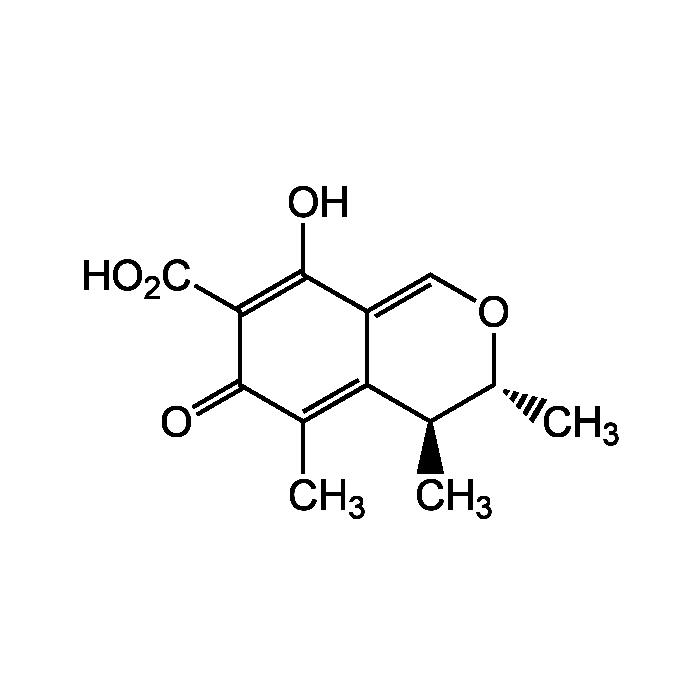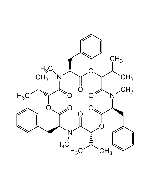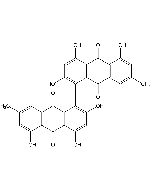Cookie Policy: This site uses cookies to improve your experience. You can find out more about our use of cookies in our Privacy Policy. By continuing to browse this site you agree to our use of cookies.
AdipoGen Life Sciences
Citrinin
As low as
45
CHF
CHF 45.00
In stock
Only %1 left
AG-CN2-0101-M0011 mgCHF 45.00
AG-CN2-0101-M0055 mgCHF 140.00
AG-CN2-0101-M02525 mgCHF 560.00

| Product Details | |
|---|---|
| Synonyms | NSC 186; BRN 0088597; Antimycin |
| Product Type | Chemical |
| Properties | |
| Formula |
C13H14O5 |
| MW | 250.3 |
| Merck Index | 14: 2327 |
| CAS | 518-75-2 |
| RTECS | DJ2275000 |
| Source/Host Chemicals | Isolated from Penicillium citrinum strain FKI-4836. |
| Purity Chemicals | ≥97% (HPLC) |
| Appearance | Yellow solid. |
| Solubility | Soluble in methanol, ethanol, methylene chloride, pyridine or dioxane. Insoluble in water, chloroform or hexane. |
| Other Product Data |
Solutions change color with changes in pH from yellow (pH 4.6) to red (pH 9.9). |
| InChi Key | CQIUKKVOEOPUDV-IYSWYEEDSA-N |
| Smiles | C[C@H]1OC=C2C(O)=C(C(O)=O)C(=O)C(C)=C2[C@@H]1C |
| Shipping and Handling | |
| Shipping | AMBIENT |
| Short Term Storage | +4°C |
| Long Term Storage | -20°C |
| Handling Advice | After reconstitution, prepare aliquots and store at -20°C. |
| Use/Stability | Stable for at least 3 years after receipt when stored at -20°C. |
| Documents | |
| MSDS |
 Download PDF Download PDF |
| Product Specification Sheet | |
| Datasheet |
 Download PDF Download PDF |
Description
- Antibiotic [1, 2].
- Antiprotozoal. Antimicrobial [3, 6].
- Cytotoxic and genotoxic in various mammalian cells [4].
- Mitochondrial permeability transition pore (MPTP) activator [5-7].
- Apoptosis inducer [7-9, 14].
- ERK and JNK signaling pathways activator [10].
- Nephrotoxic mycotoxin [11].
- Suppresses NO and iNOS expression via inhibition of the JAK/STAT-1α and NF-κB signaling pathways [12].
- Tubulin polymerization and mitotic spindle assembly inhibitor [13].
- Increases reactive oxygen species (ROS) [14].
- Induces cell cycle arrest at the G0/G1 and G2/M phase [13,14].
Product References
- Citrinin: T.S. Gore, et al.; Nature 16, 157 (1946)
- Citrinin as an Antibiotic: Y. Wang, et al.; Science 106, 291 (1947)
- Antiprotozoal activity in citrinin: A.W. Hayes, et al.; Bull. Environ. Contam. Toxicol. 15, 429 (1976)
- Cytotoxicity of citrinin in cultured kidney epithelial cell systems: M. Yoneyama, et al.; Ecotoxicol. Environ. Saf. 11, 100 (1986)
- Citrinin-induced mitochondrial permeability transition: E.J. Da Lozzo, et al.; J. Biochem. Mol. Toxicol. 12, 291 (1998)
- Antimicrobial activity of the mycotoxin citrinin obtained from the fungus penicillium citrinum: P.M. Mazumder, et al.; Anc. Sci. Life. 21, 191 (2002)
- Citrinin induces apoptosis in HL-60 cells via activation of the mitochondrial pathway: F.Y. Yu, et al.; Toxicol. Lett. 161, 143 (2006)
- Citrinin induces apoptosis via a mitochondria-dependent pathway and inhibition of survival signals in embryonic stem cells, and causes developmental injury in blastocysts: W.H. Chan; Biochem. J. 404, 317 (2007)
- Citrinin induces apoptosis in mouse embryonic stem cells: W.H. Chan; IUBMB Life 60, 171 (2008) (Review)
- Activation of ERK and JNK signaling pathways by mycotoxin citrinin in human cells: C.H. Chang, et al.; Toxicol. Appl. Pharmacol. 237, 281 (2009)
- Toxicological properties of citrinin: D. Flajs & M. Peraica; Arh. Hig. Rada Toksikol. 60, 457 (2009) (Review)
- The fungal metabolite, citrinin, inhibits lipopolysaccharide/interferon-γ-induced nitric oxide production in glomerular mesangial cells: B.H. Liu, et al.; Int. Immunopharmacol. 10, 1608 (2010)
- Mycotoxin citrinin induced cell cycle G2/M arrest and numerical chromosomal aberration associated with disruption of microtubule formation in human cells: C.H. Chang, et al.; Toxicol. Sci. 119, 84 (2011)
- Citrinin-generated reactive oxygen species cause cell cycle arrest leading to apoptosis via the intrinsic mitochondrial pathway in mouse skin: R. Kumar, et al.; Toxicol. Sci. 122, 557 (2011)










